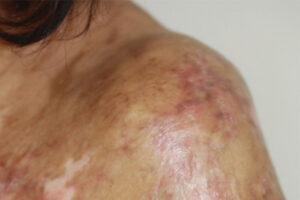Oncology
Chronic Graft-versus-Host Disease
Atypical Features of Chronic Graft-versus-Host Disease
Overview
Chronic graft-versus-host disease (cGVHD) may have some atypical manifestations that have not classically been ascribed to the disease. Efforts to describe and codify the atypical features of cGVHD are underway.
Expert Commentary
Corey Cutler,, MD, MPH, FRCPC
|
|
“The National Institutes of Health Consensus Project Task Force has recently attempted to codify some of these manifestations, building on our collective experience.”
Historically, cGVHD has been understood and classified based on its common presentations; however, it is almost certain that there are other alloimmune manifestations that may go unrecognized due to their relative rarity and/or the lack of consistent association with cGVHD. The National Institutes of Health Consensus Project Task Force has recently attempted to codify some of these manifestations, building on our collective experience. The new report by Cuvelier et al reflects this effort and gives a very nice overview of some of the more uncommon manifestations of cGVHD.
For example, there are clearly renal manifestations, such as minimal change disease or glomerulonephritis, that are associated with cGVHD. Although these manifestations are not formally recognized as cGVHD, they are immune phenomena and are characterized as autoimmune diseases when they occur outside of transplantation. There are also manifestations within both the central and the peripheral nervous systems that are likely manifestations of cGVHD. For example, there are several small fiber neuropathies that most of us see but usually do not classify as cGVHD.
While cGVHD must always be considered as a possible cause of these atypical manifestations, it is also important to explore the full differential diagnosis before attributing a condition to an atypical manifestation of cGVHD. Additionally, the publication by Cuvelier and colleagues notes that a connection between cGVHD and some manifestations is still speculative, outlining some of the steps that can be taken to further this research.
As relates to potential mimics of atypical cGVHD in the renal sphere, we know that there is a late form of microangiopathy that is more often associated with radiation and could present as glomerulonephritis or nephrotic syndrome, so that must be ruled out. We also use many treatments such as tacrolimus or vinca alkaloids that have neuropathic side effects that should not be confused with neuropathy from cGVHD. Finally, infections have the potential to mimic manifestations of cGVHD. There are several seasonal endemic viruses that can cause pericarditis, and, unless we look for echovirus or enterovirus in pericardial fluid, we might erroneously ascribe the pericarditis to cGVHD. Thus, it is good clinical practice to perform a differential diagnosis, since clearly not everything is an alloimmune phenomenon and is related to cGVHD. In general, I would say that atypical cGVHD is a diagnosis of exclusion.
References
Cuvelier GDE, Schoettler M, Buxbaum NP, et al. Toward a better understanding of the atypical features of chronic graft-versus-host disease: a report from the 2020 National Institutes of Health Consensus Project Task Force. Transplant Cell Ther. 2022;28(8):426-445. doi:10.1016/j.jtct.2022.05.038
Elghawy O, Wang JS, Hafey AC, Renaghan AD, Whitehair RM, Kindwall-Keller TL. Minimal change disease secondary to graft-versus-host disease after allogeneic hematopoietic cell transplant for myelodysplastic syndrome. Case Rep Nephrol Dial. 2022;12(1):31-37. doi:10.1159/000522333
Karakulska-Prystupiuk E, Basak G, Dwilewicz-Trojaczek J, Paluszewska M, Boguradzki P, Jędrzejczak W. Pericarditis in patients with chronic graft-vs-host disease. Transplant Proc. 2018;50(7):2218-2222. doi:10.1016/j.transproceed.2018.02.130
Nasr SH, Leung N, Said SM, et al. Membranous nephropathy with extensive tubular basement membrane deposits following allogeneic hematopoietic cell transplant: a report of 5 cases. Am J Kidney Dis. 2022;79(6):904-908. doi:10.1053/j.ajkd.2021.07.021
Ren X-Y, Liu X, Huang Q-S, et al. Incidence, risk factors, and outcome of immune-mediated neuropathies (IMNs) following haploidentical hematopoietic stem cell transplantation. Biol Blood Marrow Transplant. 2019;25(8):1629-1636. doi:10.1016/j.bbmt.2019.04.021
Wolff D, Radojcic V, Lafyatis R, et al. National Institutes of Health Consensus Development Project on Criteria for Clinical Trials in Chronic Graft-versus-Host Disease: IV. The 2020 Highly Morbid Forms report. Transplant Cell Ther. 2021;27(10):817-835. doi:10.1016/j.jtct.2021.06.001











